Magnetic flow meters are one of the most commonly used flow meters used in industries. Flow is one of the most important parameters in any industry and its accurate measurement is a must for better process control.
Magnetic flow meters are very popular because they do not have any moving parts and require very less maintenance. The pressure drop across the flow meter adversely affects the measurement accuracy. However, in the case of a magnetic flow meter, the pressure drop across it is zero. Hence, its measurement accuracy is excellent.
Working Principle of Magnetic flow Meter
The magnetic flow meter works on the principle of Faraday’s Law. According to Faraday’s law, the voltage induced across any conductor when placed at right angles to a magnetic field is proportional to the velocity of that conductor.
Faraday’s Formula
E ∝ BVL
where:
E = The voltage generated in a conductor
V = The velocity of the conductor
B = The magnetic field strength
L = The length of the conductor
The magnetic flow meter measures the flow of the electrically conductive liquids.
Magnetic Flow Meter Working Principle
An electromagnetic flow meter or magnetic flow meter consists of a transducer and a sensor that together measures the flow. Electronic flow meter sensors are placed inline of the fluid flow to measure the induced voltage generated by the liquid flowing through the pipe. The transmitter receives the voltage (emf) generated by the sensor, converts the voltage (emf) into the proportional flow, and transmits the measured flow to the control system. The faster the fluid flow, the greater the voltage signal it generates. Thus, this unique design of the magnetic flow meter allows readings of volumetric flow to be taken without moving parts.
The construction of a magnetic flow meter is such that field coils generate a magnetic field across a given area. Two electrodes placed at two opposite ends pick up the voltage generated by the moving liquid.
Now applying Faraday’s law to the magnetic flow meter, the signal voltage (i.e. E) is dependent upon the magnetic field (B), the velocity of the liquid ( V), and the total length of the conductor (i.e. L) which is the distance between electrodes in our case.
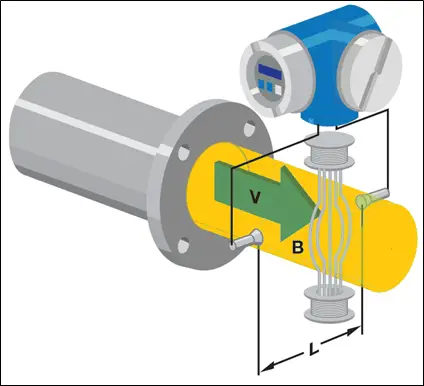
The accuracy and consistency of the magnetic flow meter are independent of the pressure, temperature, density, or viscosity of the fluid. This unique instrument allows to easy and efficiently measure the fatty viscous substances. we also call magnetic flow meters the electromagnetic flow meter and magnetometers. These three names are interchangeable, and the magnetic flow meter is the most common.
Advantages of magnetic flow meter
- The magnetic flow meter does not obstruct the flow flowing through it. This way the pressure drop is zero across a magnetic flow meter.
- The magnetic flow meter has no moving parts and hence chances of mechanical failure are almost nil. Thus, the life of a magnetic flow meter is more and makes it a maintenance-free kind of flow meter.
- Variation in pressure, density, viscosity, and the temperature does not have an impact on the working of the magnetic flow meter.
- The most advantageous property of a magnetic flow meter is that it senses flow in both directions i.e. it is bidirectional.
- It is also possible to measure Low flow using magnetic flow meters.
Limitations of Magnetic Flow Meter
- A magnetic flow meter only works for liquids whose conductivity is above 5 micro siemens/centimetre because a liquid having conductivity below 5 microsiemens/ centimeter will not generate enough voltage while passing through a magnetic field.
- Inline magnetic flow meter‘s electrode’s inspection requires the magnetic flow meter to be dropped and this activity becomes quite a big one.
- The magnetic flow meter’s cost does not vary too much for small line sizes and for large line sizes because the electronics part is necessary and remains almost the same for all line sizes.
- Any air bubble in line will give a false reading and hence continuous liquid flow should be there without any air bubbles in it.
Applications of Magnetic Flow Meter
- It is used to measure the water flow in desalination plants
- Used to measure the flow of chemicals in the chemical industry because a magnetic flow meter can measure flow as low as 0.33 litre/minute
- Used to measure the flow in wastewater management system because the system has sludge also which can cause blockage in other types of flow meter
- Certain types like Teflon-coated magnetic flow meters can be used in corrosive services too.
- Used in the food and beverage industry because magnetic flow meters can handle fluid with solid particles too.
Installation guidelines for Magnetic Flow Meter
- Avoid installing in lines creating high vibration.
- Always give proper support to the line holding the magnetic flow meter.
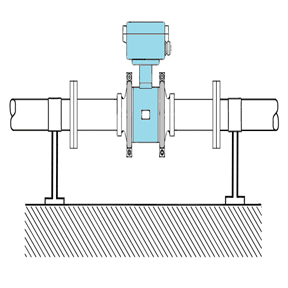
- Always install the magnetic flow meter in a horizontal position such that the flow meter is not on top of the line
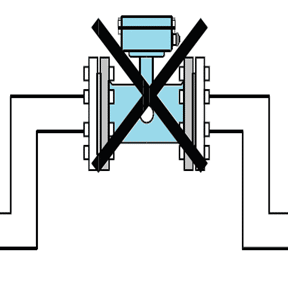
- While installing the flow meter in a vertical position do not install with flow direction going down because the sensor will not be fully filled with liquid every time which is the primary requirement for getting the highest accuracy.
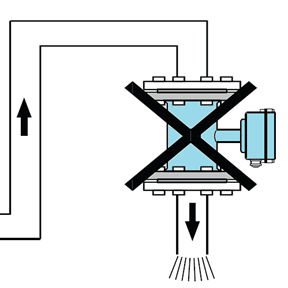
- Vertically mounting should be done such that flow goes from bottom to top which will always keep the flow meter always filled with the liquid also this is recommended installation type because the particles in the liquid will settle in the bottom and hence there will be no deposition on the sensor.
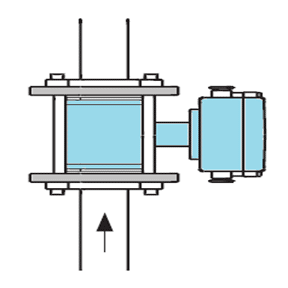
Troubleshooting in magnetic flow meter
- Unstable flow signal :
- The reason for this might be pulsating flow. To overcome this Increase the time constant
- Another reason may be air bubbles in the line. For this ensure proper flow conditions.
- No flow :
- Check whether the flow is there or not
- If the flow is ok, then inspect the electrodes because sometimes electrodes get deposition on them.
- Check coil resistance as per data provided by the vendor
- Inaccurate flow
- Verify proper grounding
- Check coil resistance as per data provided by the vendor
NOTE: The most important thing to keep in mind while working with magnetic flow meters is that generally in the field, a magnetic flow meter has 2 compartments. One for supply which is non-IS and the other for the signal which is generally IS. Never ever open a non-IS compartment in a hazardous area without taking proper precautions!
Read Next: